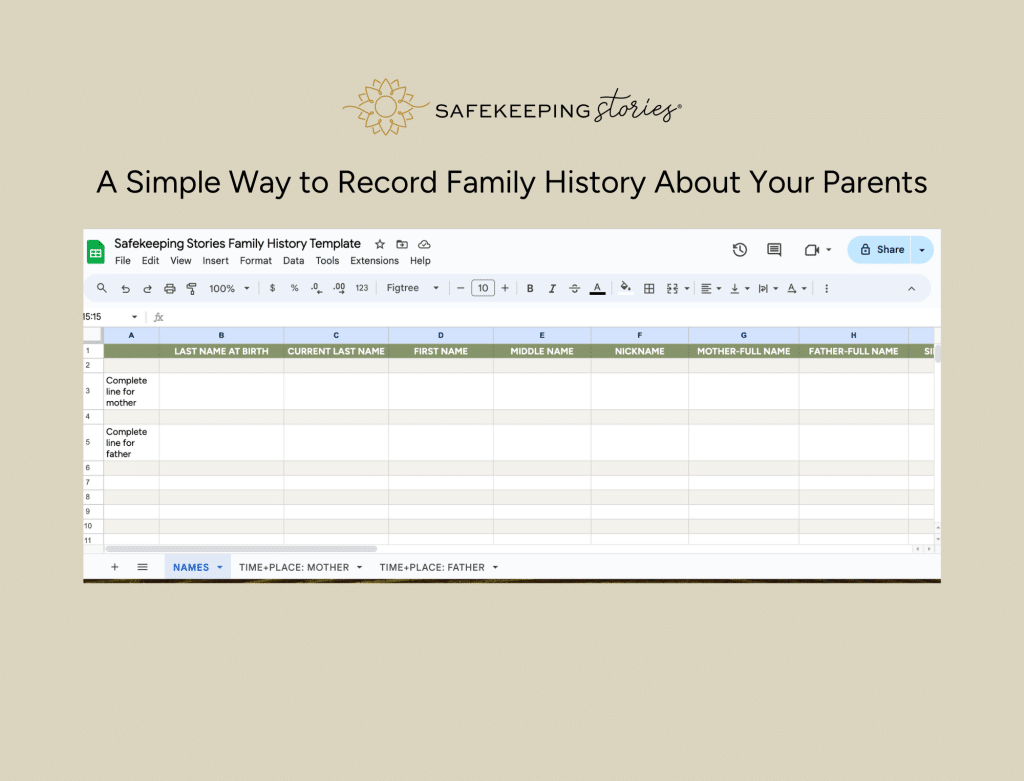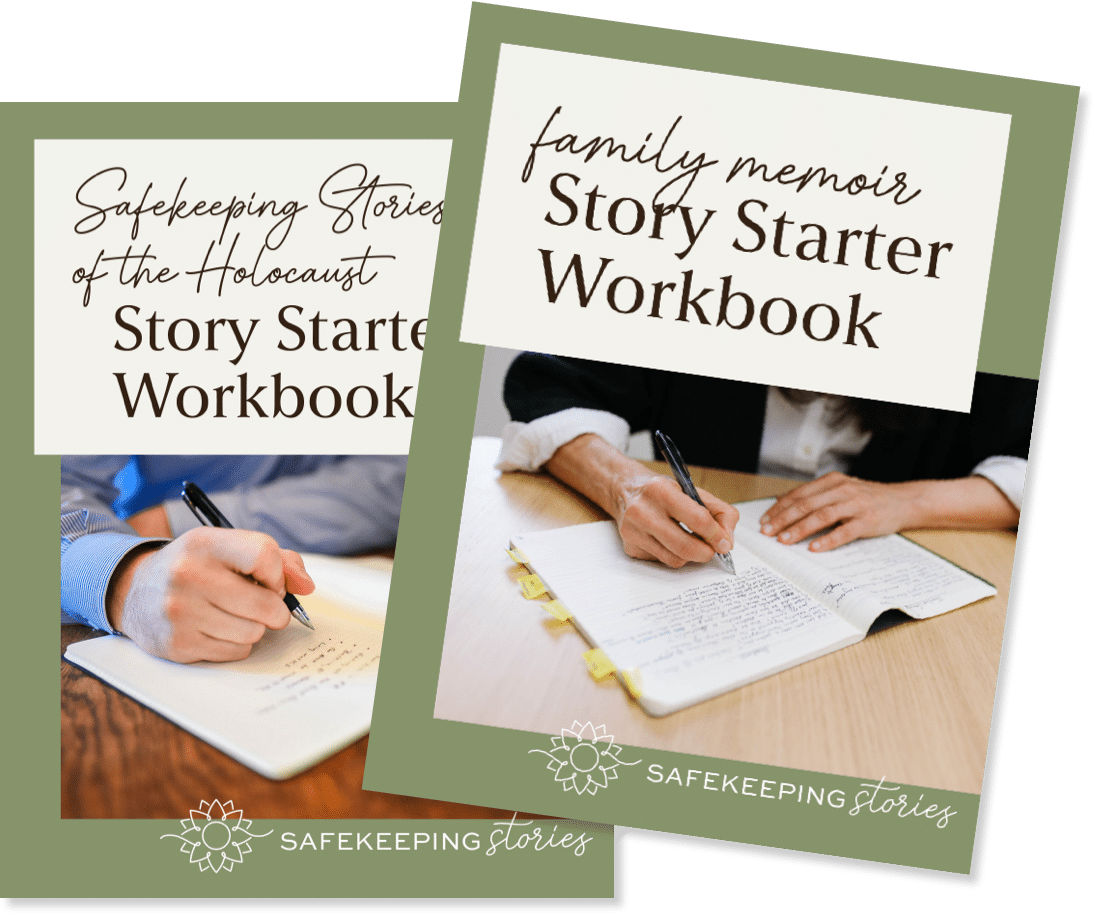If you are looking for an easy way to explore and share your parents’ past that doesn’t involve a deep dive into research or genealogy, you’ll be relieved to know there’s an easier way to record family history. In the time it takes to scroll through your social media or play a Wordle game, you can record family history by capturing facts you know about your parents’ lives. It’s the kind of stuff your kids will want to know about their grandparents when choosing names for their children and sharing their family’s background with friends.
Download the Safekeeping Stories Family History Template to gather your memories and facts.
For you, it’s everyday facts—like names, birthdates, significant life events, and places lived—the kind millions search for on websites like ancestry.com, FamilySearch, and MyHeritage. Our Safekeeping Stories Family History Template is a free Google Sheet that prompts you to explore your family history. Surprisingly, recording family history like this helps you see the bigger story of your parents’ lives.
Why You Should Record Family History About Your Parents’ Lives
I noticed that participants in our Family Memoir and Holocaust Story workshops often began their stories by listing family facts like full names, birthdates, and addresses. While recording family history is important, facts alone are not a story. I created the Safekeeping Stories Family History Template to provide them with a way to record family history quickly and easily at no cost.
Once my participants’ family facts were safely stored, they could make connections, and family facts easily transformed into a meaningful narrative.
Our template became an efficient tool for capturing family facts and helping participants see the bigger picture of their parents’ lives—and it can help you, too.
1. Record Family History to Realize What You Already Know
Making a record of family history may seem daunting, but it feels more manageable when you realize it’s just basic facts you know about your parents’ lives. You’ve celebrated their birthdays, lived with them, heard their work stories, and shared many life experiences together.
The process of recording family history can be surprisingly comforting. Fear and regret melt away as you realize you know much more than you thought. Should you decide to do family history research, you’ll be ready since the best practice is to work backward from the most recent generation.
2. Use A Family History Record to Ask Better Questions
The Safekeeping Stories Family History Template makes it easy to transform gaps in knowledge about your parents’ lives into open-ended questions. Starting with Who, What, When, Where, How, or Why helps clarify what you want to know and opens avenues for finding answers. For example, your dad worked at a factory in the 1970s, but the details elude you. Do you want to know when he worked there, where the factory was, what his role was, how he found the job, or why he left?
Effective questions are the roadmap for further exploration, enabling you to realize the next time you’re with a family member or friend that they have the answer.
Questions will allow you to discover more and create a complete family history record.
3. Record Family History to Focus on Significant Life Events
T.S. Eliot wrote, “Life is very long”—it can feel that way when you record family history. However, it’s the significant events that define a person’s journey. The Safekeeping Stories Family History Template guides you to pinpoint those significant life events so you can determine the forces that shaped your parents’ lives. Significant life events include:- Significant Losses: The death of a parent or spouse, loss of a job or home
- Life-Altering Changes: Moving, marriage, illness
- Pivotal Choices: Career decisions or personal sacrifices
- Personal Struggles, Joys, and Accomplishments: Goals, dreams, and challenges
When you focus on recording family history with the larger picture in mind, you’ll capture the events that matter and discover the deeper layers of your family story.
4. Let Your Family History Record Reveal the Story of Your Parents’ Lives
When you record family history, your parents’ life events are no longer isolated as you notice connections and patterns you never realized were there.
The person you know as “Mom” or “Dad” emerges as an individual with a fuller life story—one you understand differently from your adult perspective.
For example, as you record your father Bob’s history, you may start to see him as “Bobby,” a young boy shaped by profound loss at an early age. His mother passed away when he was eight, and his father sent him to live with his grandmother in another state. A year later, his grandmother died, too, and his father sent him to live with his recently divorced sister in a different city. Growing up, you may have accepted what you heard as the whole story: “Aunt Sue raised your dad, and she wasn’t very nice to him.” However, recording the dates and events of your father’s life reveals the complexity that eluded you as a child. You begin to see your dad’s choices, the kind of father he became, and his responses to loss as part of a larger narrative—one that helps you understand him as a person with a depth that wasn’t possible before.
5. See the Missing Pieces of Your Parent’s History as Part of Their Story
When you record family history, gaps in your parents’ past are inevitable. Sometimes, it’s because you never asked. Other times, it was because your parents didn’t have the words or support to discuss experiences that evoked shame, sadness, and fear. The result was things left unspoken. You may have sensed off-limits topics and instinctively known not to ask.
When you record family history, you may understand gaps as silence in your family story—a silence that speaks volumes about the emotional weight.
Consider adding a personal note to your family history record, such as, “Dad didn’t talk about X, which I can understand because it was painful. However, it left me with many questions about our family’s past. I want to have open conversations about what’s difficult with my children.” Recording family history this way, you honor your parents’ feelings and your own—and provide a greater understanding of your family’s journey.
Record Family History in The Safekeeping Stories Family History Template
This simple Google Sheet is free to use and easy to share since your kids likely have their own Google Drive and are familiar with the Google environment.

Step 1: Copy the Safekeeping Stories Family History Template
- Click this link to the Family History Template, and a page will appear with a button that says “Make a copy”
- Click the button to make a copy in your Google Drive. If you don’t have an account already, follow the prompts to set up an account if you don’t have one already. You can use any existing email address
- In the top left corner, change the filename from “Safekeeping Stories Family History Template” to your family name, e.g., “Green Family History”
- This copied document is private to you and is exclusively yours to edit
Step 2: Ensure Your Family History Sheet Stays Private
When you use Google Sheets to record family history, here are a few ways to keep your sheet private and secure:
- Choose a complex and unique password for your Google account
- Turn on two-factor authentication (2FA) for your Google account
- Do not set permissions when sharing the sheet: “Anyone with the link can view/edit.” Share it with specific, trusted email addresses only
- Google Sheets automatically encrypts your data, both while stored and in transit. Learn more about security here
Step 3: Start with the “Names” Tab
The “Names” tab is your starting point. Here are some tips:
- Do your best. Leave it blank if you don’t know all or part of a name. You can fill in the details later.
- Personalize your family history record
- Add a column if your parent had more than one spouse, or add a “Comment” to an individual cell
- Add a column for Hebrew names, Baptismal names, Saint Names, Godparents, Generational names, Arabic names, or Sikh names
Step 4: Record Family History by Completing a Time + Place Sheet
Next, record family history by time and place. If you don’t know the exact date, include the year or use “circa 1970” to indicate an approximate year or “circa 1970s” to indicate a decade. Begin with foundational life events:
- Birth date and location (country, state/province, city/town)
- Marriage(s)
- Birth of children
- Birth of grandchildren
- Death and burial place
Next, document significant life events:
- Significant Losses: Death of a parent, spouse, sibling, or close family member; loss of a friend, job, or home
- Life-Altering Changes: Moving, getting married or divorced, changes in financial status or health, natural disasters, world events, immigration and citizenship
- Pivotal Choices: Education decisions, career opportunities, retirement, or personal sacrifices
- Personal Struggles, Joys, and Accomplishments: Overcoming challenges, celebrating milestones, hobbies, interests, travel, languages learned, life goals, and dreams
Do You Love Exploring Your Family History?
In just eight weeks, you can bring your parent’s or grandparent’s story to life in our Family Memoir Workshop. We’ll guide you to create a short, shareable narrative your kids will cherish. Join our Workshop Waitlist and be the first to learn when registration opens. Would you prefer to work One-on-One? Learn more about our One-on-One Consulting.


